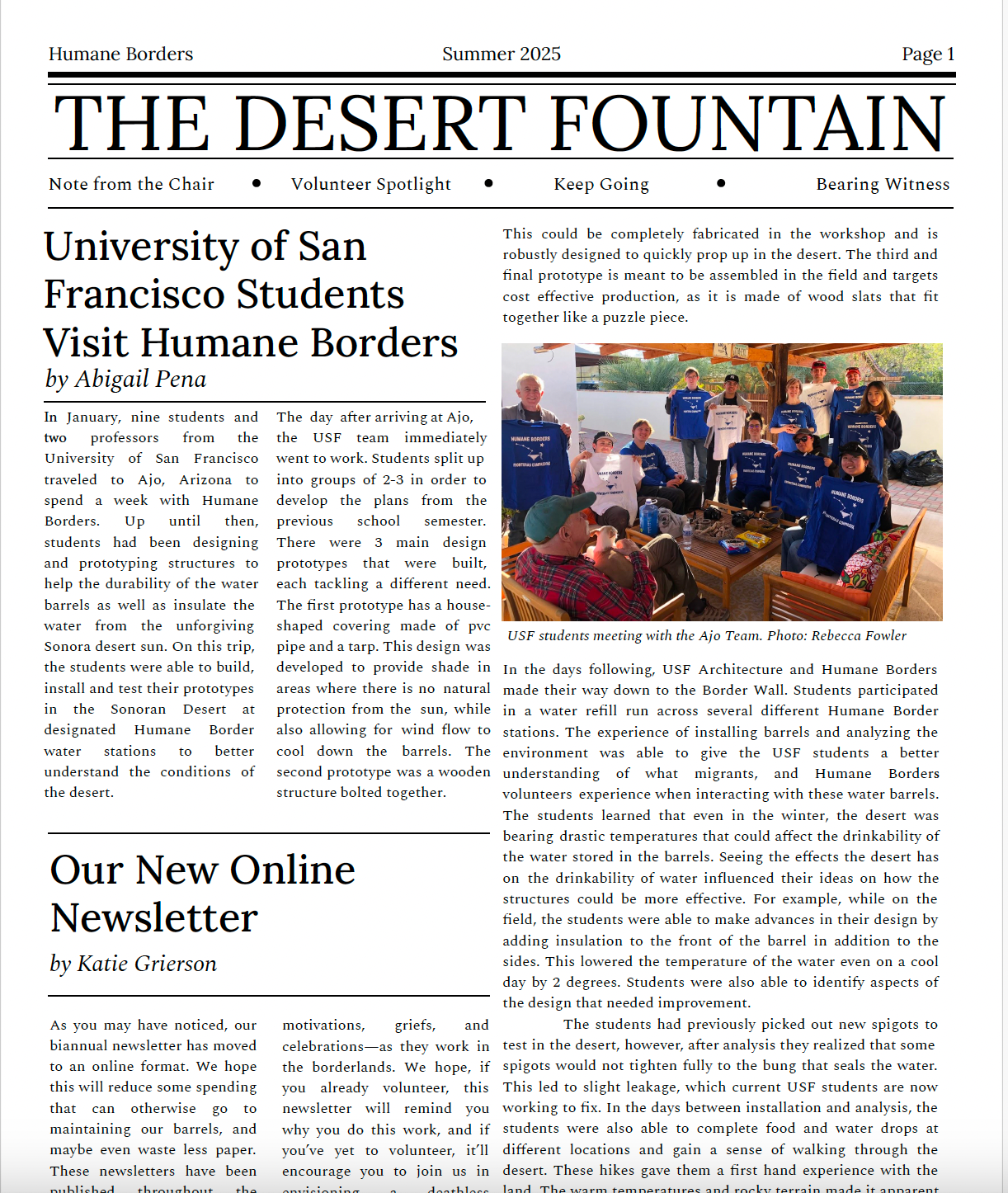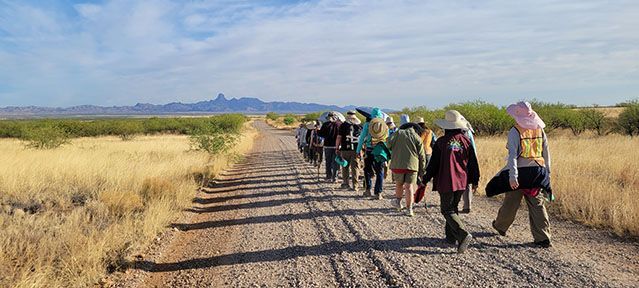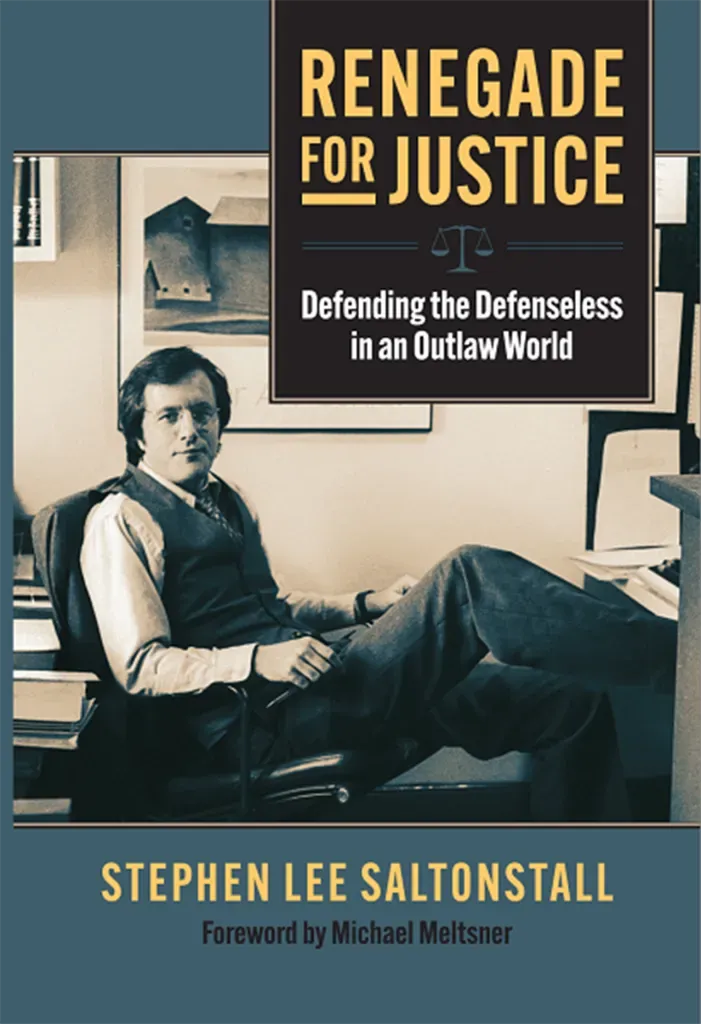Blue barrel diaries
a humane borders blog
Keep Going: On resilience and commitment at the border
By Holly Knight
Gurupreet Kaur, who would have turned 13 this year, died of heat stroke in the Sonoran Desert on June 12, 2019. She crossed with her mother and three others who were all planning to request asylum. Her small body was found not far from Quitobaquito Oasis, just one mile from the border where daytime temperatures soared to 108 °F. When the exhibit Hostile Terrain 94 traveled to the university near me, I searched for her name tag for two hours in the sector where she died. The exhibit is a visceral and visual representation of the human toll exacted by the 1994 policy of Prevention Through Deterrence. More than 4,000 handwritten toe tags were geolocated on a wall map at the exact location where remains were found in Arizona’s Sonoran Desert between the mid-1990s and 2024. I gasped when I finally discovered Gurupreet’s tag, which was buried beneath a massive pile, all telling the same story of what happens when cruel policies are carried out in one of the deadliest places on earth.
Before I traveled to Arizona in late October 2024 to help my daughter move, I had never heard of Gurupreet Kaur or the thousands of others who have died or gone missing in the land of open graves due to a 30-year-old policy I knew nothing about. While I certainly knew that the term “illegal” was dehumanizing, I didn’t know it was also misleading because crossing without papers is most often a civil offense and not a crime. I also did not know that requesting asylum was a right protected by both international and federal laws or that asylum seekers must present themselves at a port of entry or to border patrol on US soil within one year of arrival in order to request asylum. In other words, they have no choice but to cross the border without papers or permission, and they do not need to initiate the process immediately. I certainly had no idea there was a backlog of nearly 4 million asylum cases in U.S. Immigration Court, which included Gurupreet's father, with a wait time of approximately six years. In short, I did not know that millions of men, women, and children fleeing violence crossed the “right” way and either died while making the attempt or have been patiently waiting their turn for a very long time.
In 2018, I had wanted to volunteer at the border because I knew that the policy of family separation was wrong, but I was unsure I had anything to offer. During my October visit to Arizona, I learned about the work of Humane Borders and boldly asked if I could volunteer. The volunteer coordinator assured me that education was central to their mission. Together, we organized a series of water runs. And I began a deep dive: stacks of books (by Urrea, De Leon, and more) multiplied like apprentice brooms, an embarrassing number of open tabs on my computer covered topics ranging from the 100-mile border to Annual Reports of the Pima County Medical Examiner, and hours hunched over the computer trying to write about what I was learning so I could contribute—something, anything. To call what happened during those two weeks in March of 2025 of volunteering with Humane Borders “a series of water runs” is inaccurate at best.
I will never forget the drivers, Scott and Tom, and Jim, who regaled us with stories of their lives before and after their encounter with the border. They were each so different, but similar in ways that mattered most: absolute commitment to the dual mission of preventing death in the desert and creating a more just and humane border. They had vivid stories about the brutal and beautiful landscape of trackless mountains and dry arroyos, the people they will never forget, and shifting border policies that somehow produced the same inhumane results. Scott took us on a journey beyond a water station and into a canyon. Accompanied by a drumming ladder-backed woodpecker and a singing Lucy’s warbler, we found carpet shoes and blackened water jugs left by travelers—all reminders to not give up and to keep going.
Tom remembered a day of 122 °F temperatures at water station number five along the border wall, where he met a mother who was carrying her nine- or ten-year-old son who was severely disabled. Because the mother was red-faced, exhausted, and obviously at risk of heat stroke, Tom called Border Patrol for help. When the agents finally rolled up, they asked, “What the hell are we supposed to do with that sh*t?” Tom’s reply was direct and unequivocal: “I think they need some help.” I asked Jim why he thought it was important to continue doing this work when usage was decreasing. I knew he would have a good answer, and he did. “In the past two to three years, I have seen such fluctuation in border policy and crossings.
We don’t know what’s going to happen next. Humane Borders has to be a steady and consistent source of life-giving water, so people don’t die.” During an overwhelming time when the odds seem particularly long, I take refuge in these memories. I continue to learn and strike up conversations with friends and strangers who are on their own journey of understanding the humanitarian crisis at the border. I plan to raise more money so Humane Borders can keep acting as a steady and consistent presence. And it is my goal to return this year for a longer period to gather hope, be surrounded by others who are deeply committed to this work, and to keep going.
Before I traveled to Arizona in late October 2024 to help my daughter move, I had never heard of Gurupreet Kaur or the thousands of others who have died or gone missing in the land of open graves due to a 30-year-old policy I knew nothing about. While I certainly knew that the term “illegal” was dehumanizing, I didn’t know it was also misleading because crossing without papers is most often a civil offense and not a crime. I also did not know that requesting asylum was a right protected by both international and federal laws or that asylum seekers must present themselves at a port of entry or to border patrol on US soil within one year of arrival in order to request asylum. In other words, they have no choice but to cross the border without papers or permission, and they do not need to initiate the process immediately. I certainly had no idea there was a backlog of nearly 4 million asylum cases in U.S. Immigration Court, which included Gurupreet's father, with a wait time of approximately six years. In short, I did not know that millions of men, women, and children fleeing violence crossed the “right” way and either died while making the attempt or have been patiently waiting their turn for a very long time.
In 2018, I had wanted to volunteer at the border because I knew that the policy of family separation was wrong, but I was unsure I had anything to offer. During my October visit to Arizona, I learned about the work of Humane Borders and boldly asked if I could volunteer. The volunteer coordinator assured me that education was central to their mission. Together, we organized a series of water runs. And I began a deep dive: stacks of books (by Urrea, De Leon, and more) multiplied like apprentice brooms, an embarrassing number of open tabs on my computer covered topics ranging from the 100-mile border to Annual Reports of the Pima County Medical Examiner, and hours hunched over the computer trying to write about what I was learning so I could contribute—something, anything. To call what happened during those two weeks in March of 2025 of volunteering with Humane Borders “a series of water runs” is inaccurate at best.
I will never forget the drivers, Scott and Tom, and Jim, who regaled us with stories of their lives before and after their encounter with the border. They were each so different, but similar in ways that mattered most: absolute commitment to the dual mission of preventing death in the desert and creating a more just and humane border. They had vivid stories about the brutal and beautiful landscape of trackless mountains and dry arroyos, the people they will never forget, and shifting border policies that somehow produced the same inhumane results. Scott took us on a journey beyond a water station and into a canyon. Accompanied by a drumming ladder-backed woodpecker and a singing Lucy’s warbler, we found carpet shoes and blackened water jugs left by travelers—all reminders to not give up and to keep going.
Tom remembered a day of 122 °F temperatures at water station number five along the border wall, where he met a mother who was carrying her nine- or ten-year-old son who was severely disabled. Because the mother was red-faced, exhausted, and obviously at risk of heat stroke, Tom called Border Patrol for help. When the agents finally rolled up, they asked, “What the hell are we supposed to do with that sh*t?” Tom’s reply was direct and unequivocal: “I think they need some help.” I asked Jim why he thought it was important to continue doing this work when usage was decreasing. I knew he would have a good answer, and he did. “In the past two to three years, I have seen such fluctuation in border policy and crossings.
We don’t know what’s going to happen next. Humane Borders has to be a steady and consistent source of life-giving water, so people don’t die.” During an overwhelming time when the odds seem particularly long, I take refuge in these memories. I continue to learn and strike up conversations with friends and strangers who are on their own journey of understanding the humanitarian crisis at the border. I plan to raise more money so Humane Borders can keep acting as a steady and consistent presence. And it is my goal to return this year for a longer period to gather hope, be surrounded by others who are deeply committed to this work, and to keep going.



